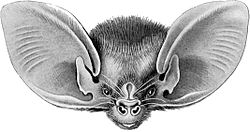- Lesser Long-eared Bat
-
Lesser Long-Eared Bat Conservation status Scientific classification Kingdom: Animalia Phylum: Chordata Class: Mammalia Order: Chiroptera Family: Vespertilionidae Genus: Nyctophilus Species: N. geoffroyi Binomial name Nyctophilus geoffroyi
Leach, 1821The Lesser Long-Eared Bat (Nyctophilus geoffroyi) is a species of vesper bat in the Vespertilionidae family. It is found only in Australia.
Contents
Classification
The lesser long eared bat falls into the category of a microbat, and more specifically, a vesper bat. These bats are usually nocturnal, living in dark caves, hollows, old trees, ceilings and hollow walls, and therefore they use echolocation systems to hunt.[1][2]Fossil record
There is not much evidence in the fossil record about the evolution of lesser long eared bats as bat skeletons are small and delicate, meaning they don’t fossilise very well.Relationship with other bats & analogous features
It has been suggested that microbats such as the lesser long eared bat evolved independently from megabats, and don’t have a common ancestor. Their wing structure and ability to fly is an analogous feature, as they have both evolved the structure independently due to a similar habitat but not because they are closely related. There are not many other similar features between the bats-microbats mostly eat insects, are nocturnal, have poorly developed eyes and large ears, whereas megabats mostly eat fruit and nectar, aren’t nocturnal and have well-developed eyes. Megabats have many characteristics that suggest they are sister taxa to primates but microbats, including lesser long eared bats are more separated on the evolutionary tree. There is also some genetic evidence to support this.Homologous features
Bat wings and butterfly wings are also analogous structures, as they are used for a similar purpose due to their habitat, but have developed from different origins. However, the forelimb structure of bat wings and bird wings are homologous features. This is because, even though one is a mammal and one is from the class ‘aves’, they share a common ancestor. This is also the same for the bone structure in the arms of humans and the flippers of whales even though they have different purposes.References
- ^ Nyctophilus geoffroyi The IUCN Red List of Endangered Species
- ^ Lesser Long-eared bat Australian Museum
Categories:- IUCN Red List least concern species
- Bats of Australia
- Mammals of Tasmania
- Mammals of Western Australia
- Mammals of South Australia
- Mammals of the Northern Territory
- Mammals of New South Wales
- Mammals of Victoria (Australia)
- Vesper bats
- Animals described in 1821
- Vespertilionidae stubs
- Western Australia stubs
Wikimedia Foundation. 2010.


